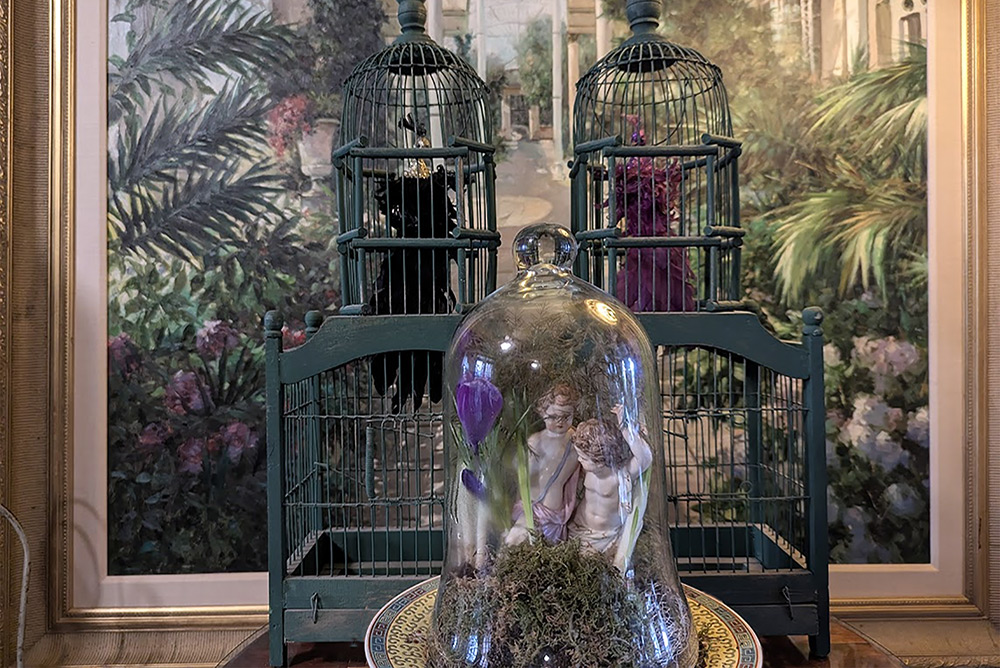
Says author Stephanie: “My tricked-out cloche stands in front of an ornamental bird cage that [husband] Greg found on the street, in front of a painting bought at a thrift shop in Juno Beach, Florida. Yes, we’re very fancy people.” / Photo by Stephanie Cavanaugh.
THERE’S NOT MUCH to be said about the garden in January. It’s brown ground studded with leafless trees with patches of color from the ferns and evergreens, like one of those hand-tinted black-and-white photos.
One wanders the usual route and along the curbs at this time of year, finds a discarded Cuisinart, or some such, that was replaced at Christmas. Or a more mysterious discard, such as the cloche I came across the other day.
This cloche is not a hat. It is a glass dome, bell-shaped, and otherwise known as a bell jar. Victorians loved them for displaying precious items and for planting and displaying small landscapes. They were also used in the garden itself to protect tender plants as they began to sprout.
I’ve seen these planted out in some garden shops, accompanied by price tags boasting a string of zeros.
These are not fairy gardens, which I hope have had their day. No little gnomes and plastic princesses, but real gardens made in delightfully small scale, with miniature plants, dew-dropped leaves, mosses, delicate ferns and flowers, and (perhaps) something ornamental.
Sometimes, they just display an object of beauty or interest, with no plants at all. Using them for display sets them apart from terrariums, whose primary purpose is growing plants. (Don’t examine that statement too closely, I fear there are holes.)
Bonus! If the primary purpose is display, and all the plants go belly-up, you can replace them with an interesting tch0tchke or, to be fancy, bibelot.
Moving right along. I don’t think I ever wanted a cloche. I’m sure I never asked for one. But there one was, abandoned on the sidewalk, a few steps from home. There wasn’t a finger smudge on it, nor a chip or crack, it was either new or kept in a cabinet, like a bell jar for a bell jar.
Finding it, you might say, was a cloche call. There. I’ve amused myself.
The set-up I found is easy. If the cloche comes with a base, add a half inch of fine gravel, top it with an inch or so of soil, add your plants and/or ornaments and nestle them in moss. If there is no base, set the cloche on a high-sided dish. The idea is to create a self-sustaining environment, one that needs little water, no fertilizer, and moderate light.
My experiment came together in about 15 minutes, once I trotted home with a small pot of moss-topped crocus bulbs from Safeway. There was enough soil and moss in the pot to cover my gravel bed. I planted the bulbs and added a beautiful, if broken, Meissen figurine, and a sprig of asparagus fern to increase the height. Don’t use wood or fabric or paper in these things; they will rot and get moldy.
Less than a week after planting, the crocuses have started to bloom. When they die, I’m thinking miniature orchids, begonias, or African violets. I’ll certainly want ferns. Maybe a pond? I have an oyster shell that would be charming . . .
If you don’t have a cloche, Etsy has nice ones. But you can also turn just about any glass vase or container—a hurricane shade, for instance—into a garden under glass. Just flip it upside down and set it on a plate.
For inspiration, visit NCYPGarden.com. And for something to do with a small boy on a snowy day, check out this tutorial on building a dinosaur terrarium.

“Cloche call”…I love it!
Charming, enlightening, what a vocabulary!